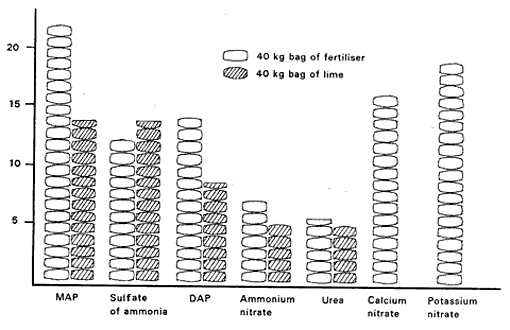
Don't let nitrogen acidify your soil
Nitrogen is a key element in plant growth, and plants need plenty of it in the growing season. But too much nitrogen can actually slow plant growth because nitrogen not used by plants is washed (leached) out of the soil, which makes soil acid.
To prevent this happening:
- use the recommended rate of nitrogen for your crop or pasture
- apply a little nitrogen often so that it is all taken up by the plants
- use the least acidifying nitrogen fertiliser you can afford
- apply lime.
Nitrogen is available in different fertiliser forms such as urea, ammonium sulphate, and ammonium nitrate. Some of these fertilisers leave the soil more acid than others, so they need different amounts of lime to counteract the acidity.
This leaflet is a guide to the acidifying effect of nitrogen fertilisers, and the quantities of lime you need to neutralise the acidity and maintain your soil pH.
Nitrogen fertilisers
Not acidifying (alkaline)
- Potassium nitrate (13% N)
- Calcium nitrate (15.5% N)
- Composted poultry manure (3% N)
None of these fertilisers are acidifying, so you do not need to apply any lime to neutralise acidity. In fact, if all the nitrogen in the nitrates is used by the plants, it is equivalent to applying 3.6 kg of lime for every kg of nitrogen.
However, these fertilisers are all relatively expensive methods of applying nitrogen. If you have acid soil and also need potassium, you might find potassium nitrate useful to apply to improve your soil pH quickly. Composted poultry manure is useful in sandy soils and high rainfall periods, because the nitrogen is released slowly, matching plant uptake, so very little nitrogen leaches away.
Slight acidifying
- Urea (46% N)
- Ammonium nitrate (34% N)
These products are only slightly acidifying. If all nitrogen in them is used by the plants, you do not need any lime at all.
However, if it rains heavily after you apply the fertiliser and all the nitrogen leaches out, you need to apply 3.6 kg of lime for every kg of nitrogen applied to maintain your soil pH.
Because these quantities of nil kg and 3.6 kg represent the extreme cases, use a quantity halfway between these two to maintain pH levels, that is, around 2 kg of lime for every kg of nitrogen.
| 1 kg N | 2.0 kg lime |
| 1 bag urea (40 kg) | 36.8 kg lime |
Moderately acidifying
- Diammonium phosphate (DAP) (18% N)
If all nitrogen applied is used by the plants, you need 1.8 kg of lime per kg of nitrogen. If all nitrogen applied is leached, you need 5.3 kg of lime per kg of nitrogen. On average, use 3.5 kg of lime for every kg of nitrogen.
| 1 kg N | 3.5 kg lime |
| 1 bag DAP (40 kg) | 25.2 kg lime |
Severly acidifying
- Sulfate of ammonia (21% N)
- Mono-ammonium phosphate (MAP) (11.3% N)
These fertilisers are so acidifying that even if all the nitrogen is taken up by the plants, you need to apply around 4 kg of lime for every kg of nitrogen. If all the nitrogen is leached, you need to apply 7 kg of lime for every kg of nitrogen. On average, use 5.5 kg of lime for every kg of nitrogen.
| 1kg N | 5.5 kg lime |
| 1 bag sulfate of ammonia (40 kg) | 46.2 kg lime |
| 1 bag MAP (40 kg) | 24.7 kg lime |
Mixed fertilisers
Mixed fertilisers contain several different nutrients for convenience, but tend to be dearer than single fertilisers. When you use them, be aware of the type and percentage of nitrogen in the fertiliser so that you can calculate how much lime you need to maintain soil pH.
Nitrogen application
If you apply nitrogen fertilisers in small amounts frequently, the plants will be able to take up most of the nitrogen, and there will be little likelihood of leaching. Spreading the fertiliser instead of banding it around trees will also reduce the likelihood of severe acidity in small areas. However, banding is preferred when direct drilling seed for pasture and crops, particularly when only small amounts of nitrogen are used, and during dry times when surface application is risky. Only limited amounts of fertiliser should be applied in dry winter and spring months, and droughts, to prevent fertiliser salts building up in the soil.
For more advice on this subject, see your local NSW Agriculture horticulturist or agronomist.

Source: From the Soil Sense leaflet 2/92, Agdex 534, produced by Rebecca Lines-Kelly, formerly soils media officer, Wollongbar Agricultural Institute, for CaLM and NSW Agriculture, north coast region, under the National Landcare Program, August 1992.

